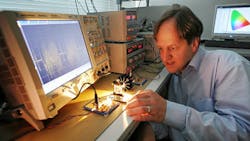With all of the fanfare surrounding heterogeneous networks, it is widely known that supplementing cellular-network coverage with smaller cells can significantly increase capacity and user data rates. Yet this approach has proven difficult to facilitate due to current spectrum, energy, and interference limitations. The development of a new testbed, however, could be the next milestone on the path toward fifth-generation (5G) wireless communications. Interestingly, visible light communications are at the heart of this approach.
Designs for this prototype utilize a next-generation, massive multiple-input multiple-output (MIMO) technique known as spatial modulation. Developed through a partnership between National Instruments and the University of Edinburgh, it has the capability to power a highly energy-efficient increase in capacity. The technology utilizes a combination of NI PXI Express hardware and NI LabVIEW system design software to show spatial modulation techniques over a wireless RF channel. This effort is led by Professor Harald Haas, lead researcher at Edinburgh, and Professor Cheng-Xiang Wang, head of the Advanced Wireless Technologies Lab at Heriot-Watt University.
Recently, the team reached 3.5 Gb/s from a single color light-emitting diode (LED), allowing for the creation of a the realistic testbed. A micro-LED with a bandwidth of 60 MHz was used together with a modified version of orthogonal frequency division multiplexing (OFDM) and optimized bit and power allocation for each subcarrier. A high-speed oscilloscope and arbitrary waveform generators created and captured the signal, translating it through MATLAB and then AWG. The analog signal was then passed through an amplifier and a bias-T to add direct-current (DC) offset and reach the necessary signal power level. Next, it was directly fed to the LED. The received signal from the photo detector was directly fed and captured on the oscilloscope.
In 2011, Haas demonstrated LiFi—a concept that uses visible light communications over a single-channel, point-to-point link. LiFi—in conjunction with the previously mentioned hardware and software—has the potential to create higher-density optical networks (optical attocell networks). These networks can supposedly harness massive MIMO gains in both the optical and RF spectrums for energy-efficient, indoor wireless communications. The first LiFi units, Li-1st, are currently being shipped in the U.S. and European markets. Li-1st is a bidirectional, plug-and-play unit that uses arbitrary LED light sources, turning them into high-data-communication devices through an infrared uplink.
When asked if at some point, RF usage could be minimized in favor of visible light for communications, a representative from National Instruments said: “RF has the power to provide connectivity in high-mobility scenarios as well as in certain environments, such rural outdoors. The fact is that visible light communication (VLC) provides vast, free, and unregulated wireless transmission sources. And indoor environments have plenty of light sources with the supporting infrastructure. It would be a waste not to use these resources, and light will be part of the future mix of wireless transmission resources. One should use them when it is most appropriate.”
An example would be an indoor room environment. Traditional cellular-radio base-station signals would have to pass through multiple walls to reach the user, as they are primarily deployed on the streets. The light in the room, however, could provide a signal that is five to six times better in quality because it is in the room itself. Signal quality would be higher if the lights were dimmed down to levels where they appear off, such as during daytime. Higher signal quality of course translates into higher data rates, as stated by the Shannon-Hartley theorem.
To broaden its research capabilities, the Edinburgh team is using the LabVIEW reconfigurable I/O (RIO) architecture for rapid prototyping. For the building of prototypes, it has relied on the NI FlexRIO Software Defined Radio Bundle with reconfigurable FPGAs and interchangeable I/O adapter modules. Those prototypes have the ability to operate beyond the rates of current commercial RF wireless systems. In terms of 5G, massive MIMO, energy-efficient and spectrum-efficient communications, the team sees no drawback in utilizing spatial modulation—although it certainly won’t eliminate RF usage entirely.
About the Author
Iliza Sokol
Associate Digital Editor
Iliza joined the Penton Media group in 2013 after graduating from the Fashion Institute of Technology with a BS in Advertising and Marketing Communications. Prior to joining the staff, she worked at NYLON Magazine and a ghostwriting firm based in New York.
